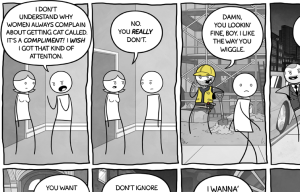
Credit: NY Press
(Content Warning: Sexual abuse, sexual violence)
The idea of someone molesting your child is terrifying for any parent (unless the parent is the child molester, which is 37% of the time).
The pain, fear, and trauma they may experience at such a young age are frightening to consider. It’s enough to make any parent freak out and want to never ever think about it again.
And then we hope it will just never happen to our own child.
Except your daughter has a 1 in 4 chance and your son has a 1 in 6 chance of being molested before the age of 18. According to a studied reported by TIME magazine, gender non-conforming children assigned male at birth are “nearly three times as likely to suffer sexual abuse in childhood compared with gender-typical boys” while gender non-conforming children assigned female at birth are “60% more likely to be abused sexually than conforming girls.” Children with disabilities are 2.9 times more likely than children without disabilities to be sexually abused.
I know you don’t want to hear it or believe it. But it’s true.
And these statistics are too high for any parent to risk staying uninformed about the reality of child sexual abuse and not talking to their child about it.
On top of that, the majority of children never report sexual abuse when it’s happening. They’re often afraid of their parents’ reactions or fear getting into trouble. They don’t know how to explain what happened to them or believe what the abuser told them to keep them quiet.
Now, you can never protect your child fully from ever being molested. But you can do a lot to reduce your child’s vulnerability to sexual abuse and increase the chances they’ll tell you after something happens.
You just need to talk to them directly about it and do it many times.
Why Talking About Sexual Abuse Is Like Talking About Crossing the Street
The idea of talking to your kid about sexual abuse probably seems worse than even talking to them about sex.
You don’t want to scare them (or yourself) in the process. You don’t want to strip away their innocence. You don’t want to introduce them to how much violence and abuse there is in the world.
But given the statistics, your child is much more likely to be molested than to be hit by a car when crossing the street.
So try thinking of these conversations as being just as important (and frankly more important given the statistics) than teaching your child how to cross the road safely.
It’s one of the things you teach your child as a sign of love and care and as a way to keep them safe.
Remember that when you take a deep breath and begin talking to your child about their body.
Ways of Approaching the Conversation
1. Frame the conversation for yourself as a way of loving your child.
Starting from a loving place and not a scared place will help create the calm environment for your child. This will help them really listen to the words you’re saying. If you’re frightened and stressed, they will react primarily to that fear and not register what you’re saying as much.
It’s also important to not treat the subject like its taboo or dirty (which is how we often treat anything related to sex). Even when parents try to hide their feelings, children are often very perceptive and pick up on small cues telling them that something is wrong.
They then may think talking about someone hurting them might be wrong even if you say it’s not. So speak from a calm, casual, and loving frame of mind when having these conversations.
2. Begin talking to them as young as 2 years old.
This may seem very early but children under 12 are most at risk at 4 years old. Even if they can’t speak well, children at this age are busy figuring out the world. And they certainly understand and remember a lot more than adults usually realize.
For example, when giving a bath, tell them where their private parts are and that the parent is seeing and touching them to clean them but that normally nobody should.
3. Teach them the actual names of their private parts.
When you begin teaching them parts of their body like ears, eyes, and toes, also teach them the real names of their private parts like “vagina” and “penis” and not their “cute” names. This gives them the right words to use if someone is hurting them and makes sure the person being told understands what’s happening. It’s also important to teach both female and male anatomy because the abuser can be of any gender and they need to know how to describe what happens to them.
In one case, a child told her parent that her stomach was hurting. When they took her to the doctor, he informed them that her vagina showed signs of rape. Their little daughter had been trying to tell them what was happening but she just didn’t know what to call her vagina. So she said stomach instead.
4. Share the only instances when their private parts can be seen and touched.
An age appropriate concept for a young child to understand is that nobody – including a parent or caregiver – should see or touch their private parts (what a swimming suit covers up) – unless they’re keeping them clean, safe, or healthy.
But also make sure they know that even in these situations, if someone is hurting them, they can still say, “stop, it hurts” and tell their parent immediately.
Some examples to help them understand what you’re talking about are when you’re giving them a bath or a doctor is seeing them. Ask them if that’s an example of keeping them clean, safe, or healthy as you’re doing it.
5. Teach them that private parts are special.
When talking about this topic, it’s important to not create a taboo or dirty feeling around their private parts. Instead parents can teach their child that their private parts are so special that they’re just for them and no one else, unless someone is helping them keep their private parts clean, safe, or healthy.
You can also ask them what it feels like when someone is touching them their in order to keep it clean, safe, or healthy. This will help them understand the difference between that type of touching and someone touching them sexually.
Also explain that if someone is making them feel “tingly and nice” in their private parts, it’s still not appropriate and they should tell you immediately. It’s important to not make them wrong or ashamed for having any sexual pleasure since many children do touch themselves. Instead make it clear that it’s a problem if someone else is doing it to them.
It’s also important to teach them that it’s inappropriate to touch other people’s private parts, even if an adult asks them to. And if someone does, they should tell you immediately.
This is an important step to help children develop a healthy sexuality before discussing sex itself with them. When they are older, of course, you can have the conversation about when it is appropriate to touch another person’s private parts and give and receive sexual pleasure.
6. Teach them (and respect) their right to control their bodies.
This flies in the face of what we often teach our children – that adults have absolute authority over everything and children have to do what they’re told. The problem is that this only teaches them to not speak up when they’re feeling hurt and scared because of what an adult is telling them to do.
Instead, teach your child that their body is theirs and no one has the right to hurt their bodies even when a grown up is doing it. For children, it’s very empowering to have permission to say “no” to an adult if they’re uncomfortable with the request.
For example, when you’re at a social event, don’t make your child kiss or hug anyone. Instead let your child know they can give a kiss, hug, handshake, or nothing to people they see and it’s entirely up to them. And when an adult tries to make them give them a hug and they don’t want to, encourage the child to say “no” and support their decision verbally if needed.
7. Explain that no one should physically hurt them, especially in their private parts.
85% of child sexual abuse is perpetrated by someone they know. It may be a parent, relative, family friend, neighbor, teacher, or religious leader. It may be a man, woman, or another child.
It can be anyone. No one unfortunately is on the safe list. In fact, children are most vulnerable with the family members and acquaintances. So make sure your child knows that no one can hurt their bodies no matter who they’re with – even when they’re with their parent.
It’s also important that they understand you’re talking to them about this because you love them and want them to be safe. Just like you teach them about crossing the road because they might get hit by a car, you’re also teaching them that someone might sexually hurt them. It doesn’t mean it will happen.
But in case someone tries to, your child will know they can say “no, stop that” and tell you what happened without you being upset with them.
8. Encourage them to trust their gut around their safety.
While parents shouldn’t instill a fear of people in their child, they should support their child in trusting their gut instinct. By trusting their intuition, children will both be more empowered around making their own choices about who’s safe instead of relying primarily on what a parent told them. This is important because a parent won’t always be there with them.
One way is to tell the child before social events that if they ever feel uncomfortable with someone – even if nothing has happened, they can leave the room and tell their parent. Even if it looks “rude,” they should know that they will not be punished for simply leaving the room. Their sense of safety comes before the need to be “polite.”
9. Explain that a secret is still a secret when shared with the parents.
Many abusers tell their child victims that what happened was a secret and to not tell anyone, especially their parents. So it’s important to teach them early on that secrets are still kept secret if they tell their mom or dad.
Additionally, they should understand anyone who wants them to keep secrets from their parents shouldn’t be trusted and they should definitely tell their parents about it.
10. Tell them that you will believe them if someone is hurting them and they won’t be in trouble.
Many abusers tell their victims that no one will believe them and create a sense of shame around what happened. Children in general, usually blame themselves and take responsibility for things that happen in their lives, regardless of who’s actually responsible for it.
Given this, children often fear what their parent will do if they tell them, including being punished. Make sure they know without a doubt that you won’t be upset, that they’ve done the right thing, and that you’re proud of them for telling them the truth.
But Here’s the Most Important Thing To Do
If you remember nothing else, remember this – these conversations should be ongoing, open, and casual.
You wouldn’t tell your child just once to not cross the street without looking both ways. You’d tell them several times and probably even quiz them about what they need to do when they want to cross the road.
It’s the same deal for sexual abuse – except you have this conversation from a much earlier age and it changes as your child grows up and becomes a teenager.
While nothing can keep your child 100% safe, if you keep an open, casual dialogue with your child, keep an eye out for signs, and pay attention to how your child responds to people, you’ve significantly reduced the risk of someone sexually abusing your child.
For more resources, please visit:
- List of Organizations Serving Survivors of Sexual Violence per State
- National Sexual Assault Hotline at 1-800-656-HOPE (4673)
- National Sexual Violence Resource Center
- Stop It Now
- PreventConnect
- DC Rape Crisis Center
[do_widget id=”text-101″]
This article was written with input from the DC Rape Crisis Center. The DCRCC helps survivors and their families heal from the aftermath of sexual violence through crisis intervention, counseling, and advocacy. Follow them on Facebook.
Sandra Kim is the Founder and Executive Director of Everyday Feminism. She brings together her personal and professional experience with trauma, personal transformation, and social change and gives it all a feminist twist.
Search our 3000+ articles!
Read our articles about:
Our online racial justice training
Used by hundreds of universities, non-profits, and businesses.
Click to learn more
Most Read Articles
- « Previous
- 1
- …
- 30
- 31
- 32



















